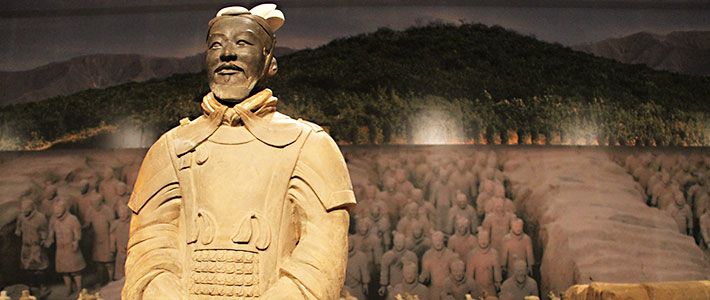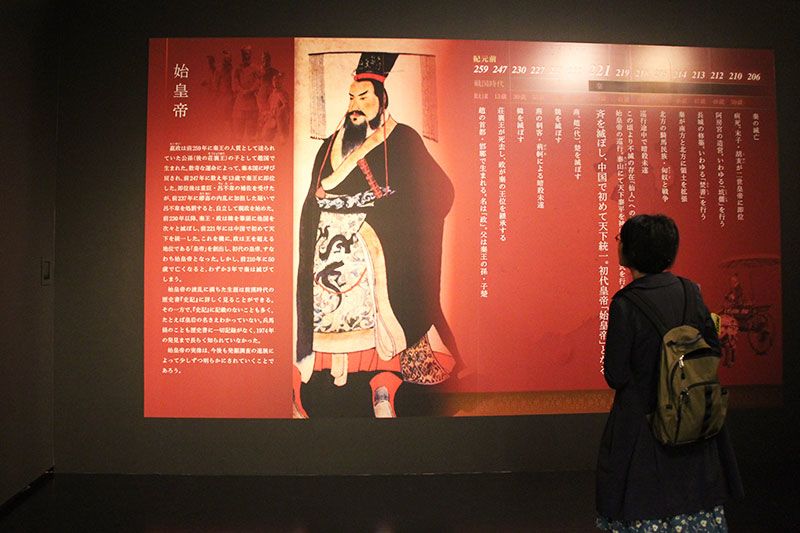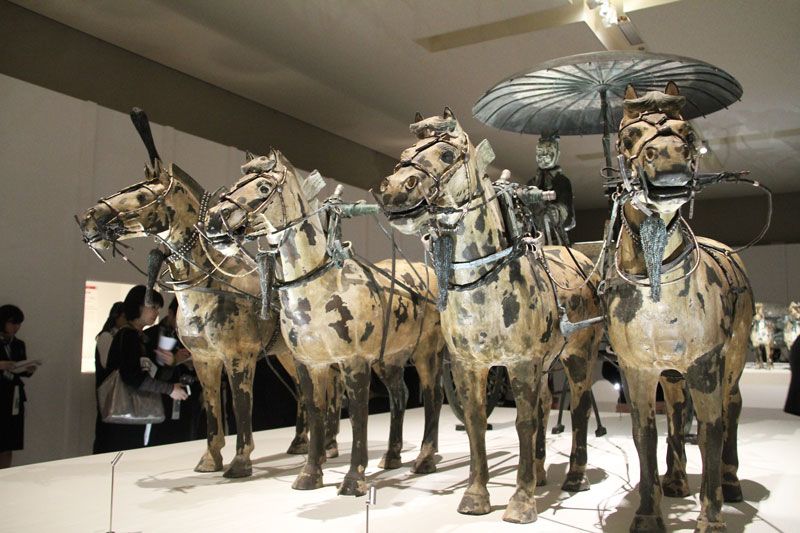
China’s Terracotta Army Comes to Japan
Politics Culture- English
- 日本語
- 简体字
- 繁體字
- Français
- Español
- العربية
- Русский
Qin Shi Huangdi (259–210 BC) was the first person to unify China and ruled as the first emperor of the Qin dynasty (221–206 BC).
With territorial unification complete, he set his hand to economic and cultural unification. His accomplishments included standardizing weights and measures, expanding his realm’s networks of roads and canals, adopting a single monetary currency, standardizing the written script, and linking formerly separate defensive fortifications to create the Great Wall of China.
Shi Huangdi’s mausoleum, discovered in 1974 in Shaanxi Province, comprises a necropolis of stupendous scale, inhabited by thousands of terracotta warriors and many terracotta horses. Authoritative scholars have dubbed the mausoleum site the most important archeological discovery of the twentieth century.
Japan’s exhibition comprises 80 figurines—10 originals and 70 faithful replicas—along with precise replicas of a pair of bronze chariots and of their teams of bronze horses and numerous other funerary items. Most of the figurines are nearly life size or larger.
“The mausoleum of Qin Shi Huangdi is regarded as a recreation of the ruler’s orderly realm,” explains the exhibition curator Kawamura Yoshio. “And we have sought [in our exhibition at the Tokyo National Museum] to convey the scale of the two-hectare excavation site.”
Four years of planning and negotiations culminated in the signing ceremony for the exhibition contract in Xi’an, Shaanxi, in March 2015. Bi Sheng, the vice director of Shaanxi Cultural Heritage Promotion Center, hosted the ceremony. Chinese media coverage of the event emphasized his praise for the bilateral effort that went into the exhibition.
“[Bi] expressed great expectations for a successful exhibition,” reported local media, “and voiced heartfelt gratitude for the hard work by staff members [of the Japanese museums and of the Shaanxi Cultural Heritage Promotion Center].” Japanese representatives also gave thanks. “We are extremely grateful for maximal commitment by our Chinese counterparts. For we are well aware of the tight restrictions on overseas lending [of the Shi Huangdi mausoleum artifacts] and of the incessant demand.”
The organizers of Japan’s Great Terracotta Army of China’s First Emperor exhibition faced and overcame daunting adversity. Their negotiations began in the wake of the Great East Japan Earthquake and the accompanying nuclear power plant disaster. And they continued through the worsening of Sino-Japanese relations caused by the territorial dispute over the Senkaku (Diaoyu in Chinese) Islands. So the exhibition opening in October 2015 was a tribute to impressive, bilateral perseverance.
A Full Complement of Warriors and Horses
Kawamura and his team at the TNM have succeeded spectacularly in conveying a feel for the scale and atmosphere of the excavation site. Visitors first see an artist’s rendering of Shi Huangdi and a summary of his life and accomplishments on a large information panel and then two bronze chariots carrying the emperor’s spirit. After a series of exhibits that provide historical and geographical background, the exhibition climaxes with a stunning view of 80 terracotta figurines, including generals, staff officers, archers, cavalrymen, and infantrymen.
 A profile of Qin Shi Huangdi on an information panel at the Tokyo National Museum exhibition
A profile of Qin Shi Huangdi on an information panel at the Tokyo National Museum exhibition
Archaeologists estimate that the terracotta figurines at the Shi Huangdi mausoleum site number some 8,000. They have yet to open what they believe to be a sealed underground palace that serves as Shi Huangdi’s tomb. And one can only guess at what lies inside.
A huge auditorium houses extraordinary exhibits of hundreds of terracotta warriors and horses at the excavation site in Shaanxi. For Tokyoites unable to make the trip to China, the TNM has provided a next-best experience. The organizers have even hauled in earth like that in Shaanxi to reproduce the ambience of the excavation setting.
Kawamura stresses the careful attention that the exhibition organizers in Japan have devoted to ensuring the safety of the figurines while optimizing visual accessibility. The Chinese were especially concerned about the danger posed by earthquakes in Japan. And the protracted negotiations reportedly included detailed presentations by the Japanese about their failsafe measures for protecting the figurines.
Shi Huangdi’s Dreams of Eternity
The initial find of terracotta warriors and horses at Shi Huangdi’s mausoleum in 1974 engendered the appellation “terracotta army,” which has stuck. But excavation work at the mausoleum site has subsequently yielded bronze work, too, and nonmilitary figures.
 The spirit of Qin Shi Huangdi in a bronze chariot pulled by bronze horses
The spirit of Qin Shi Huangdi in a bronze chariot pulled by bronze horses
Two highlights of the exhibition are half-size replicas of bronze chariots and teams of bronze horses, which were unearthed near the mausoleum. One of the chariots features carved dragon-like motifs and ornate gold and silver trim.
One nonmilitary terracotta artifact on display is a mysterious giant. Severe damage to the work has rendered difficult any definite judgment as to its identity, but the figure appears to be an acrobatic performer.
All the artifacts from the mausoleum excavation sites reveal the adverse effects of more than two millennia spent underground. The bright colors that adorned the figurines and other items when new have flaked and faded. What remains, however, is sufficient to jog the imagination and furnish a compelling feel for the works’ original appearance. The exhibition offers visitors the opportunity to view 10 original works from the mausoleum and replicas for which the conscientious artistry included reproducing even the traces of color.
The terracotta warriors and horses are from three excavation pits that span a total of 2 hectares. Those pits have reached just a handful of the some 200 chambers believed to surround Shi Huangdi’s still-unopened tomb. While the historic accomplishments of the First Emperor were great, the scale of the necropolis is mind-boggling.
Historical records report that the central chamber of the mausoleum included rivers and a sea filled with mercury “water” and that the ceiling bore a rendering of a starry sky. Analyses of soil samples from the excavation pits lend credence to those accounts. They reveal high concentrations of mercury, a substance that tends to migrate upward through soil. “He presumably sought to position himself for eternity,” speculates Kawamura, “at the center of an orderly universe.”
(Originally written in Japanese by Miki Takajirō of Nippon.com and published on November 25, 2015. Banner photo: A recreation of the mausoleum of China’s first emperor, Qin Shi Huangdi, at the Tokyo National Museum.)
museum world heritage site Terracotta Army Shaanxi Province Qin Shi Huangdi First Emperor Qin dynasty Japanese-Chinese exhibition bronze chariots and horses
